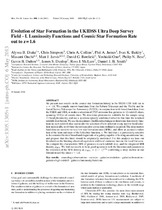| dc.contributor.author | Drake, Alyssa B. | |
| dc.contributor.author | Simpson, Chris | |
| dc.contributor.author | Collins, Chris A. | |
| dc.contributor.author | Jarvis, Matt | |
| dc.date.accessioned | 2018-02-07T10:36:32Z | |
| dc.date.available | 2018-02-07T10:36:32Z | |
| dc.date.issued | 2013 | |
| dc.identifier.citation | Drake, A.B. et al. (2013). Evolution of star formation in the UKIDSS ultra deep survey field - I. Luminosity functions and cosmic star formation rate out of z = 1.6. Monthly Notices of the Royal Astronomical Society, 433(1): 796 - 811 | en_US |
| dc.identifier.issn | 0035-8711 | |
| dc.identifier.uri | http://dx.doi.org/10.1093/mnras/stt775 | |
| dc.identifier.uri | http://hdl.handle.net/10566/3486 | |
| dc.description.abstract | We present new results on the cosmic star formation history in the SXDS-UDS field out to
z = 1.6. We compile narrow-band data from the Subaru Telescope and the Visible and Infrared
Survey Telescope for Astronomy (VISTA) in conjunction with broad-band data from
the SXDS and UDS, to make a selection of 5725 emission-line galaxies in 12 redshift slices,
spanning 10 Gyr of cosmic time. We determine photometric redshifts for the sample using
11-band photometry, and use a spectroscopically confirmed subset to fine tune the resultant
redshift distribution.We use themaximum-likelihood technique to determine luminosity functions
in each redshift slice and model the selection effects inherent in any narrow-band selection
statistically, to obviate the retrospective corrections ordinarily required. The deep narrow
band data are sensitive to very low star formation rates (SFRs), and allow an accurate evaluation
of the faint end slope of the Schechter function, α.We find that α is particularly sensitive
to the assumed faintest broadband magnitude of a galaxy capable of hosting an emission line,
and propose that this limit should be empirically motivated. For this analysis we base our
threshold on the limiting observed equivalent widths of emission lines in the local Universe.
We compute the characteristic SFR of galaxies in each redshift slice, and the integrated SFR
density, ρSFR. We find our results to be in good agreement with the literature and parametrize
the evolution of the SFR density as ρSFR (1 + z)4.58 confirming a steep decline in star
formation activity since z ~ 1.6 | en_US |
| dc.language.iso | en | en_US |
| dc.publisher | OUP | en_US |
| dc.rights | This is the pre-print version (From arXiv:1305.1305) of the article published online at: http://dx.doi.org/10.1093/mnras/stt775 | |
| dc.subject | Cosmology | en_US |
| dc.subject | Observations | en_US |
| dc.subject | Surveys | en_US |
| dc.subject | Galaxies | en_US |
| dc.subject | Evolution | en_US |
| dc.subject | High-redshift | en_US |
| dc.subject | Luminosity functions | en_US |
| dc.title | Evolution of star formation in the UKIDSS ultra deep survey field - I. Luminosity functions and cosmic star formation rate out of z = 1.6 | en_US |
| dc.type | Article | en_US |
| dc.privacy.showsubmitter | FALSE | |
| dc.status.ispeerreviewed | TRUE | |
| dc.description.accreditation | Web of Science | |

